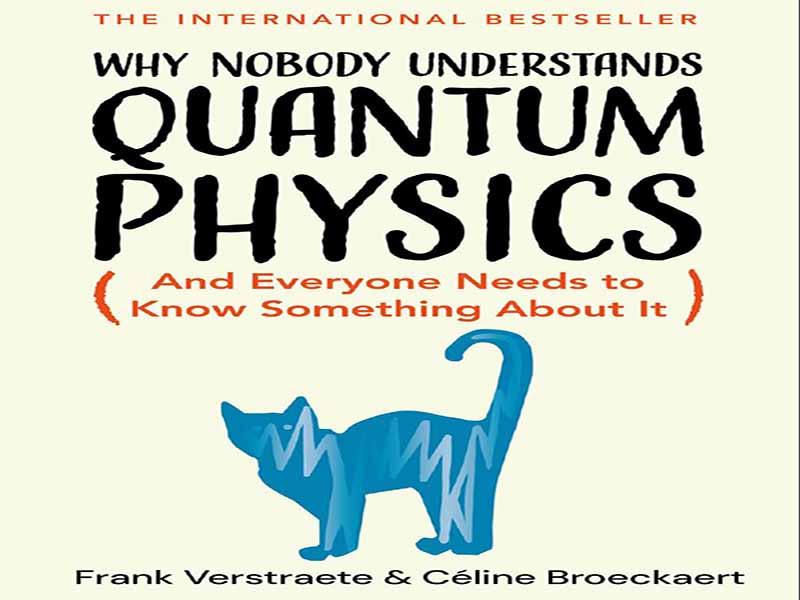- عنوان کتاب: Why Nobody Understands Quantum Physics
- نویسنده: Frank Verstraete Céline Broeckaert
- حوزه: فیزیک کوانتومی
- سال انتشار: 2025
- تعداد صفحه: 360
- زبان اصلی: انگلیسی
- نوع فایل: pdf
- حجم فایل: 5.36 مگابایت
این کتاب نتیجهی برخورد فرهنگها است: بین تلاش علمی برای «ریاضیسازی» جهان، که به تدریج اسرار آن را آشکار میکند، و زیبایی و شگفتیای که در قلمرو هنر متعالی با آن مواجه میشویم؛ بین کشف الگوهای متقارن در جهان مادی ما و سادگی و شکوه موسیقی شوبرت؛ بین غیرقابل پیشبینی بودن ذاتی یک سیستم کوانتومی و احساسات عمیقاً متناقض موجود در نارسیس و گلدموند هرمان هسه. نکته این است: هیچ برخوردی وجود ندارد. معادلهی شرودینگر به همان اندازهی سمفونی نهم بتهوون به کانون فرهنگی ما تعلق دارد. درک اینکه چگونه مکانیک کوانتومی به جهان ما رنگ میبخشد، به همان اندازهی تحسین رنگهای باشکوه در نقاشیهای کلیمت لذتبخش است. درک اینکه چگونه تقارن به عنوان یک اصل سازماندهی مرکزی عمل میکند و مانع از کوچک شدن ما به اندازهی یک نخود فرنگی میشود، به همان اندازه ایستادن در مقابل شکوه گرند کنیون فروتنانه است. در اصل، فیزیک در پی دستیابی به چیزی است که میکلآنژ هنگام خیره شدن به بلوک مرمری که بعدها به مجسمه داوود تبدیل شد، در سر میپروراند: مشاهده و توصیف طبیعت به گونهای که تمام مواد اضافی آن تراشیده شود و تنها جوهره واقعی باقی بماند. با این حال، یک تفاوت اساسی وجود دارد: در حالی که هنر معاصر و هنر صدها یا هزاران سال پیش به یک اندازه ارزشمند هستند و احساسات قوی یکسانی را برمیانگیزند، اما واقعاً بر یکدیگر بنا نمیشوند. هنر دائماً خود را از نو میسازد و باید اصیل باشد (یا نباشد). این در مورد فیزیک صدق نمیکند، جایی که یک نظریه در یک پیشرفت یکپارچه بر پایه نظریه دیگری بنا میشود. مکانیک نیوتنی جای خود را به نظریه نسبیت انیشتین داد که به نوبه خود به نظریه میدان کوانتومی تکامل یافت. قلمرو کوانتومی زیر اتمی، اسرار عمیقی را در مورد شیمی، ماده و عملکرد ستارگان آشکار کرد. کیمیاگری به یک علم تجربی تبدیل شد که قادر به تبدیل جیوه به طلا است. و دقیقاً همین است که داستان فیزیک کوانتومی را تا این حد جذاب و خواندنی میکند: این داستان، داستان افراد بیشماری است که هر کدام بر اساس ایدههای یکدیگر، انقلابهایی را شعلهور میکنند که اساساً درک ما از جهان را تغییر میدهند. این داستان چگونگی توانایی تعداد انگشتشماری از مفاهیم بنیادی کوانتومی در درک مجموعهای بیپایان از پدیدههای طبیعی است. فرضیه این کتاب ساده است: فیزیک کوانتومی به هیچ وجه غیرقابل درک نیست. برعکس، میتوان آن را برای همه قابل فهم کرد. با درک چند مفهوم بنیادی – مانند تقارن، اصل طرد و اصل عدم قطعیت – هر کسی میتواند با دنیای اتمی ارتباط برقرار کند، دنیایی که اساس کاربردهای فناوری متعددی را که هر روز از آنها استفاده میکنیم، تشکیل میدهد. پیچیدگی ذاتی و ماهیت غیرشهودی فیزیک نباید برای مرموز کردن آن استفاده شود. این دقیقاً خلاف کاری است که یک کتاب عامهپسند باید به دنبال آن باشد. همچنین نباید از خوانندگان انتظار داشت که هر خط استدلالی را دنبال کنند – این فقط با زبان دقیق ریاضیات امکانپذیر است. در عوض، فلسفه این کتاب تشویق خوانندگان به تمرکز بر خود ایدهها است، زیرا این ایدهها بسیار شهودیتر و مهمتر از استنتاجهای فنی پشت آنها هستند. ما قصد نداریم – و لزومی هم ندارد – که ریاضیات کامل فیزیک کوانتومی را در کتابی بدون فرمول توضیح دهیم. هدف ما چیز کاملاً دیگری است: الهام بخشیدن به خوانندگان برای دیدن و احساس چیزهای جدید و نگاه کردن به جهان از دیدگاهی تازه و الهام گرفته از کوانتوم. فیزیک کوانتومی کار میکند و ما در آستانه یک انقلاب کوانتومی دوم هستیم – انقلابی که عمیقاً فناوری ما را متحول خواهد کرد. هر کسی که در مورد سازوکارهای اساسی و زیباییهای جهان ما کنجکاو است، باید حداقل درک اولیهای از فیزیک کوانتومی داشته باشد. این ماموریت این کتاب است.
This book is the result of a clash of cultures: between the scientific quest to ‘mathematize’ the world, gradually unravelling its mysteries, and the beauty and amazement we encounter in the realm of transcendent art; between uncovering symmetrical patterns in our material world and the simplicity and splendour of Schubert’s music; between the inherent unpredictability of a quantum system and the deeply conflicting emotions found in Hermann Hesse’s Narcissus and Goldmund. The point is: there is no clash. Schrödinger’s equation belongs just as much to our cultural canon as Beethoven’s Ninth Symphony. Understanding how quantum mechanics gives colour to our world is just as delightful as admiring the splendid colours in Klimt’s paintings. Understanding how symmetry serves as a central organizing principle, preventing us from shrinking into a mere pea, is as humbling as standing before the majesty of the Grand Canyon. In essence, physics aspires to achieve what Michelangelo envisioned when he gazed upon the marble block that would become David: to observe and describe nature in such a way that all excess material can be chipped away, leaving only the true essence. However, there is a fundamental difference: while contemporary art and art from hundreds or thousands of years ago is equally valuable and arouses equally strong emotions, they do not truly build upon each other. Art constantly reinvents itself and has to be (or not be) original. This does not apply to physics, where one theory builds on another in a seamless progression. Newtonian mechanics gave way to Einstein’s theory of relativity, which in turn evolved into quantum field theory; the quantum realm of the subatomic unveiled profound mysteries about chemistry, matter and the workings of the stars; alchemy transformed into an experimental science capable of turning mercury into gold. And this is precisely what makes the story of quantum physics so captivating and so fascinating to tell: it is a story of countless individuals, each building on each other’s ideas, igniting revolutions that fundamentally reshape our understanding of the world. It’s the story of how a handful of foundational quantum concepts enable us to comprehend an endless array of natural phenomena. The premise of this book is simple: quantum physics is far from incomprehensible. On the contrary, it can be made accessible to all. By understanding a few foundational concepts – such as symmetry, the exclusion principle and the uncertainty principle – anyone can connect with the atomic world, which forms the basis of numerous technological applications we use every day. The inherent complexity and counterintuitive nature of physics must not be used to mystify it. That’s precisely the opposite of what a popularizing book should seek to do. Nor should readers be expected to follow every line of reasoning – that is only possible in the precise language of mathematics. Instead, the philosophy of this book is to encourage readers to focus on the ideas themselves, as these are much more intuitive and important than the technical deductions behind them. We do not intend – nor is it necessary – to explain the full mathematics of quantum physics in a book without formulas. What we aim to do is something else entirely: to inspire readers to see and feel new things, and to view the world from a fresh, quantum-inspired perspective. Quantum physics works, and we are on the verge of a second quantum revolution – one that will profoundly transform our technology. Anyone who is curious about the fundamental workings and beauty of our world should have at least a basic understanding of quantum physics. That is the mission of this book.
این کتاب را میتوانید از لینک زیر بصورت رایگان دانلود کنید:
Download: Why Nobody Understands Quantum Physics




































نظرات کاربران